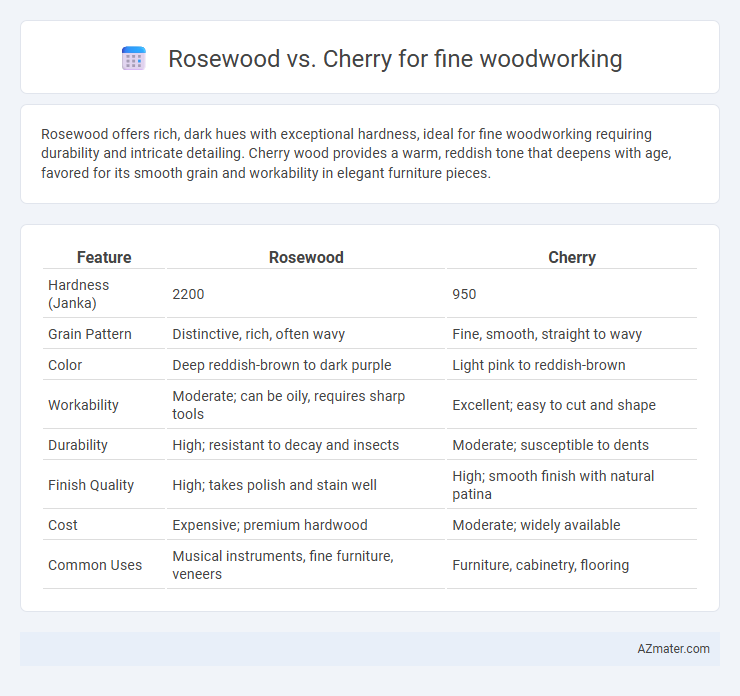Rosewood offers rich, dark hues with exceptional hardness, ideal for fine woodworking requiring durability and intricate detailing. Cherry wood provides a warm, reddish tone that deepens with age, favored for its smooth grain and workability in elegant furniture pieces.
Table of Comparison
| Feature | Rosewood | Cherry |
|---|---|---|
| Hardness (Janka) | 2200 | 950 |
| Grain Pattern | Distinctive, rich, often wavy | Fine, smooth, straight to wavy |
| Color | Deep reddish-brown to dark purple | Light pink to reddish-brown |
| Workability | Moderate; can be oily, requires sharp tools | Excellent; easy to cut and shape |
| Durability | High; resistant to decay and insects | Moderate; susceptible to dents |
| Finish Quality | High; takes polish and stain well | High; smooth finish with natural patina |
| Cost | Expensive; premium hardwood | Moderate; widely available |
| Common Uses | Musical instruments, fine furniture, veneers | Furniture, cabinetry, flooring |
Introduction: Comparing Rosewood and Cherry for Fine Woodworking
Rosewood and cherry are premium hardwoods favored in fine woodworking for their durability and aesthetic appeal. Rosewood offers rich, dark tones with natural oils that enhance its resistance to decay and wear, making it ideal for elegant furniture and musical instruments. Cherry features warm, reddish hues that deepen over time and a smooth grain, providing versatility and a classic look prized by artisans.
Botanical Origins and Species Overview
Rosewood, primarily derived from Dalbergia species such as Dalbergia nigra and Dalbergia latifolia, is prized for its dense grain and rich dark hues ranging from deep reddish-brown to purples and black streaks. Cherry wood originates from Prunus serotina, widely known as black cherry, and features a smooth grain with warm reddish tones that deepen with age and exposure to light. Both woods belong to different botanical families; Rosewood is part of Fabaceae, famed for its hardness and natural oils, while Cherry falls within Rosaceae, valued for its workability and elegant finishing qualities.
Appearance and Grain Patterns
Rosewood is prized for its deep, rich hues ranging from dark brown to purplish-black, often featuring dramatic, swirling grain patterns that create a luxurious, exotic appearance in fine woodworking. Cherry wood offers a warm, reddish-brown tone that deepens with age, characterized by smooth, straight grain and occasional subtle waves, providing a classic and elegant look. The striking contrast and complexity of rosewood grain make it ideal for decorative accents, while cherry's uniformity and rich color make it a versatile choice for refined furniture and cabinetry.
Color Variations and Aging Characteristics
Rosewood exhibits rich, dark brown to purplish hues with natural streaks of black or darker brown, creating a dramatic and luxurious appearance that deepens and gains warmth over time. Cherry wood presents a warm, reddish-brown tone that darkens gracefully with age, developing a rich patina that enhances its smooth grain and classic elegance. Both woods improve aesthetically as they age, but Rosewood's color shifts are more pronounced and complex compared to Cherry's subtle and uniform darkening.
Workability and Machinability
Rosewood offers excellent workability with a smooth, fine grain that machines well, producing clean edges and a polished finish suitable for intricate detailing. Cherry wood has moderate machinability, sometimes posing challenges due to its varying density, but it sands and finishes beautifully, enhancing its rich, warm tones. Both woods respond differently under tools, with rosewood favoring precision cuts and cherry excelling in shaping and finishing processes.
Durability and Hardness
Rosewood boasts exceptional durability with a Janka hardness rating ranging from 1,200 to 2,000, making it highly resistant to wear, dents, and scratches, ideal for fine woodworking projects requiring longevity. Cherry, with a moderate Janka hardness of about 950, offers a good balance of hardness and workability but is softer and more prone to dents compared to rosewood. For projects demanding superior hardness and resistance, rosewood stands out as the preferable choice, while cherry provides ease of carving and a smooth finish with moderate durability.
Finishing Qualities and Surface Treatments
Rosewood offers a rich, natural luster and deep color variations that enhance its finishing qualities, making it ideal for fine woodworking projects requiring a luxurious appearance. Cherry wood, known for its smooth grain and warm, reddish-brown hue, accepts stains and finishes evenly, producing a consistent and elegant surface treatment. Both woods respond well to polishing and oiling, but Rosewood's denser grain provides superior durability and resistance to wear in finished pieces.
Common Applications in Fine Woodworking
Rosewood is prized in fine woodworking for its rich color and dense grain, making it ideal for musical instruments, high-end furniture, and decorative veneers. Cherry wood, with its smooth texture and warm reddish-brown hue that darkens over time, is commonly used for cabinetry, intricate carvings, and elegant furniture pieces. Both woods offer durability and beauty but are selected based on the desired aesthetic and project requirements.
Sustainability and Environmental Impact
Rosewood and cherry differ significantly in sustainability and environmental impact, with cherry being a more eco-friendly choice due to its faster growth rate and wider availability. Rosewood faces critical challenges from overharvesting and illegal logging, leading to strict regulations under CITES that limit its trade and increase its environmental footprint. Choosing cherry reduces ecological harm while still offering strong aesthetic appeal and durability for fine woodworking projects.
Cost and Availability Considerations
Rosewood, prized for its rich color and natural oils, tends to be significantly more expensive and less readily available than cherry, primarily due to export restrictions and sustainability concerns. Cherry wood offers a more affordable and accessible option, with widespread availability in North American markets and consistent grain quality suitable for fine woodworking. Cost-sensitive artisans often prefer cherry for large projects, while rosewood is reserved for luxury pieces where budget accommodates its premium price.

Infographic: Rosewood vs Cherry for Fine woodworking
 azmater.com
azmater.com